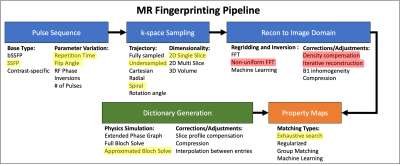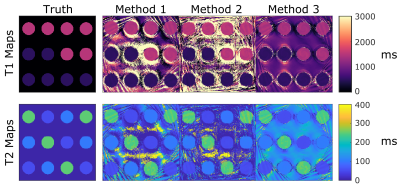1Physical Measurement Laboratory, National Institute of Standards & Technology, Boulder, CO, United States, 2Information Technology Laboratory, National Institute of Standards & Technology, Boulder, CO, United States, 3Department of Biomedical Engineering, Case Western Reserve University, Cleveland, OH, United States

Figure 1: Overview of the MR Fingerprinting Pipeline.
The pipeline consists of acquisition (blue), dictionary generation (green), and property map creation (orange). At each stage of the pipeline there are many design choices that can be implemented, some of which are listed here. Each of these choices can influence the accuracy and precision of the resulting property maps. The design choices analyzed in this effort are highlighted in yellow (same across methods) and red (variable across methods).

Figure 3: Simulated phantom reconstructed property maps for each method compared to the true values.
Qualitatively, the T1 and T2 maps generated with each method are in good agreement with the true values in the digital phantom. Spiral artifacts can be seen in the background where there is no signal, appearing stronger near the edges of the field of view where they begin to infiltrate the reconstructed maps within each circle.